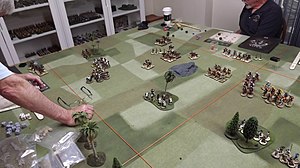Miniature wargaming is a form of wargaming in which military units are represented by miniature physical models on a model battlefield. Miniature wargames are played using model soldiers, vehicles, and artillery on a model battlefield, with the primary appeal being recreational rather than functional. Miniature wargames are played on custom-made battlefields, often with modular terrain, and abstract scaling is used to adapt real-world ranges to the limitations of table space. The use of physical models to represent military units is in contrast to other tabletop wargames that use abstract pieces such as counters or blocks, or computer wargames which use virtual models. The primary benefit of using models is immersion, though in certain wargames the size and shape of the models can have practical consequences on how the match plays out. Models' dimensions and positioning are crucial for measuring distances during gameplay. Issues concerning scale and accuracy compromise realism too much for most serious military applications.
Miniature Wargames can be skirmish-level, where individual warriors are controlled, or tactical-level, where groups are commanded. Most wargames are turn-based, involving movement and combat resolved through arithmetic and dice rolls. The setting of a game determines the type of units used, with popular historical themes including WWII, the Napoleonic Wars, and the American Civil War, while Warhammer 40,000 is the leading fantasy setting. Models, historically made from lead or tin, are now typically made of plastic or resin, with larger companies favoring plastic for its mass-production advantages. While some companies sell pre-painted models, most require assembly and customization by players. In historical miniature wargames, generic models are used, but fantasy wargames, like Warhammer, feature proprietary models, making them more expensive.
The community is social, with conventions and clubs playing a significant role. Painting and assembling models are integral aspects of the hobby. The hobby primarily attracts older enthusiasts due to the time, skill, and financial investment required.


